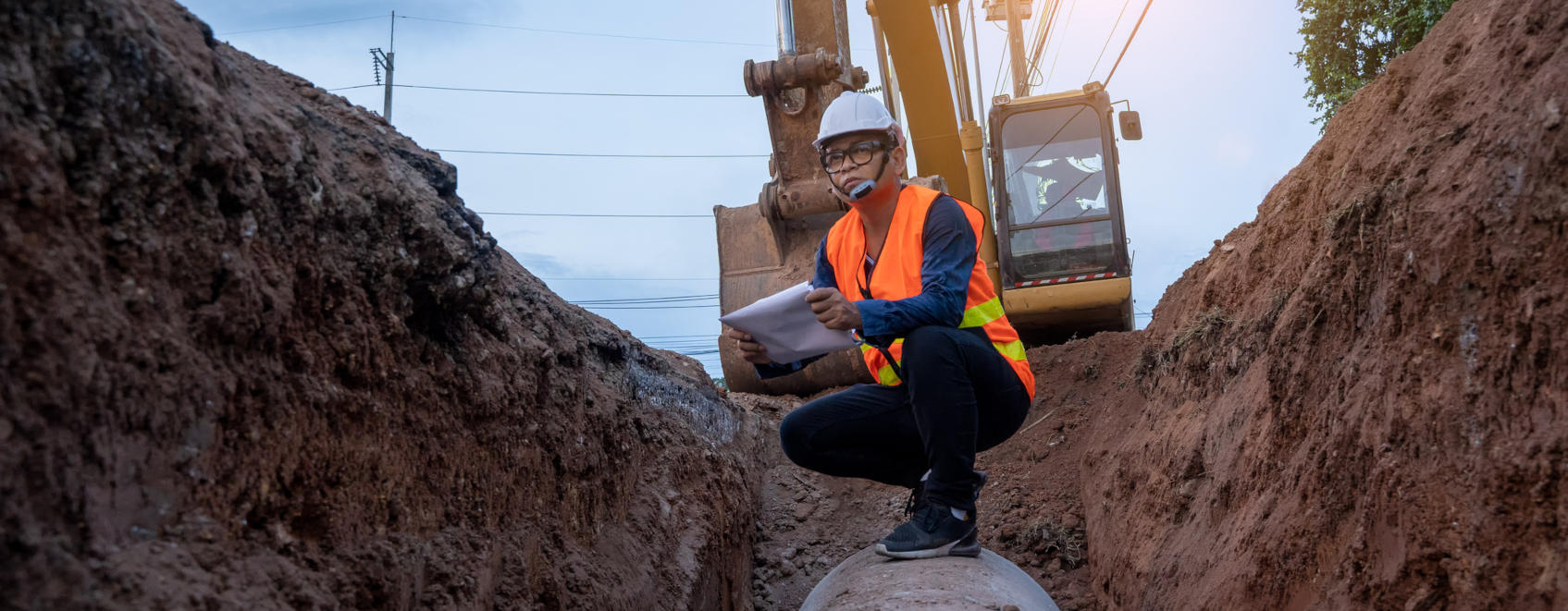Trenching safety rules for construction sites

Excavating and trenching are common jobs on modern construction sites, but they can also be some of the most dangerous due to the risk of collapses and cave-ins.
According to the Occupational Safety & Health Administration (OSHA), dozens of construction workers are killed each year in excavation and trenching accidents. In 2022 alone, 35 workers died doing this kind of work — a dramatic increase from previous years that forced OSHA to roll out enhanced enforcement and oversight measures for companies doing this work.
The sad fact is that most excavation and trenching-related deaths could be prevented with good risk management practices. Here’s what workers, site supervisors and risk management professionals need to know about trenching and excavation safety to make sure everyone gets home safe at night.
What's the difference between an excavation and a trench?
An excavation and a construction trench are both types of earthworks that involve digging into the ground, but they differ in their purpose and size.
Excavation describes the process of digging a hole or removing soil for various purposes, such as laying a foundation or digging a basement. Excavations can be of varying sizes and depths, depending on the project requirements, and are typically dug using larger equipment such as backhoes, bulldozers or excavators.
A construction trench is a narrow, elongated excavation that’s typically dug to install pipes, cables or other underground utilities. Trenches are defined by OSHA as the depth is generally greater than the width but the width is not greater than 15 feet measured at the bottom. They can be dug using handheld tools or small excavators.
Why are excavations and trenches so dangerous?
Both earthworks can be prone to cave-ins or collapses under the right conditions, with little to no warning to those working inside them. When this happens, the results are often deadly. A cubic yard of soil can weigh more than 3,000 pounds, easily crushing or suffocating workers trapped underneath.What specific factors play into cave-ins and collapses on site?
- Soil instability: Wet, loose or sandy soils are more likely to collapse than dense, clay-like soils.
- Water: Water is a significant factor in many trench collapses. Heavy rain or a high water table can cause soil to become saturated and lose its stability.
- Heavy equipment: Construction machinery, such as backhoes and bulldozers, can put pressure on the soil around a trench or excavation, increasing the risk of collapse.
- Vibrations: Vibrations from machinery or equipment can unsettle the soil, making it less stable.
- Slope: The angle of the walls in a trench can affect its stability. If the walls are too steep, they can collapse due to the weight of the soil pressing against them.
- Weather conditions: Extreme conditions such as heavy rain, snow or strong winds can cause soil erosion, increasing the risk of a collapse.
Trenches are more prone to cave-ins and collapses due to their narrow and elongated shape, and so they require additional safety measures to be taken to prevent accidents.
Keeping trenches and excavations safe for all
When working in an excavation or trench, it's important to take certain safety precautions to prevent accidents. Some of these are required by law, while others are best practices recommended by risk management experts in the field.Key trenching safety precautions include:
- Protective systems: OSHA requires all trenches deeper than 5 feet to have protective systems in place to prevent cave-ins. These can include:
- Shoring, which involves installing support systems to prevent the trench walls from collapsing.Sloping, which involves cutting the trench walls at an angle to prevent collapse.
- Benching, which involves creating a series of steps or benches in the trench walls.
- Shielding, which protects workers working in a trench. These are also known as "trench boxes."
- Proper site preparation: Heavy equipment and materials should be kept at least 2 feet away from trench edges.
- Proper training: Workers involved in trenching should receive training on the proper procedures for working in and around trenches. This can include how to use protective systems, how to identify hazards, and how to respond in case of an emergency.
- Inspections: Trenches should be inspected daily by workers and supervisors to identify any potential hazards, such as soil instability or water accumulation. Crews should also test for atmospheric hazards such as low oxygen, hazardous fumes and toxic gases when deeper than 4 feet.
- Communication: There must be effective communication between workers in the trench and those above ground. This can include using hand signals, radios or other communication devices to ensure that everyone is aware of potential hazards.
- Monitoring weather conditions: Workers and supervisors should keep an eye on the weather, as heavy rain or flooding can increase the risk of cave-ins and collapses.
UFG Risk Control consultants can help you evaluate construction site safety, design an improvement plan and put it into practice. UFG insurance agents and policyholders, contact our risk control staff at 800-828-2705 or email us at riskcontrol@unitedfiregroup.com for assistance.
